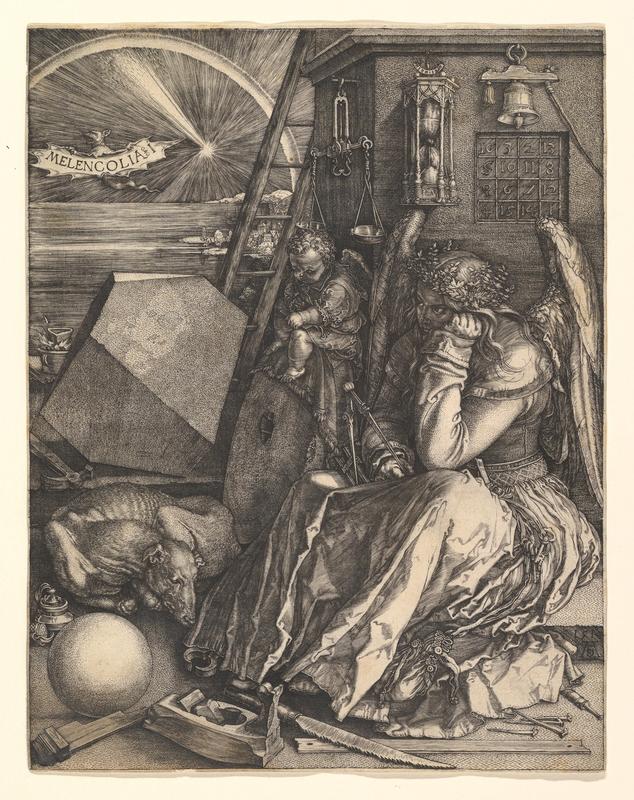More about Melencolia I
- All
- Info
- Shop

Sr. Contributor
Albrecht Durer’s print Melancholia I was created during his break from painting.
It is an allegorical representation of one of the four humours, melancholy, and is part of his series of three master engravings known as Meisterstiche. Their subjects are the three virtues of medieval scholasticism–morality, theology, and intellect. The other two of the three engravings are Knight, Death and the Devil and Saint Jerome in His Study. Art historian Erwin Panofsky considered them companion pieces, with the Knight representing the life of a Christian, St Jerome representing the life of a Saint, and Melancholia I showing the life of the genius.
Durer himself was considered to have a melancholic temperament. Melancholic people were considered to be solitary and unsociable, stereotyped as saturnine misers; and melancholia was linked to insanity, but also to creative genius. In this piece, Durer reinvents the image of the melancholic, depicting a winged personification sitting with her head rested on her hand, deep in thought. She is holding a caliper and other tools associated with geometry, the one of the seven liberal arts considered essential for artistic creation. She is the original tortured artist.
Durer employed the use of geometry in his work, employing mathematical principles, striving for classical perfection. Although he hailed from the Netherlands, he spent a lot of time in Italy developing an original style that was influenced by Italian Renaissance. He was conventionally attractive and had a humongous ego, often painting self-portraits. His most famous being his Christ-like portrayal.
Durer created this print in the year 1514, a tumultuous time for the artist after his reluctant realization of the financial benefits of prints over painting, and the same year as the death of his mother. At the time, artistic genius was considered the first and lowest of the three geniuses, the others being reason and spirituality. Durer reflects this in his depiction of her muscular body and tiny wings, unable to support her in flight. Despite her intellect, she is unable to attain higher realms of abstract thought.
Sources
- Cox, Simon. Decoding the Lost Symbol (New York: Simon and Schuster: 2009).
- Hanssen, Beatrice ."Portrait of Melancholy (Benjamin, Warburg, Panofsky)." MLN 114, no. 5 (1999): 991-1013.
- “Melencholia I.” The Met Museum. November 16, 2019. https://www.metmuseum.org/en/art/collection/search/336228
- Panofsky, Erwin. The Life and Art of Albrecht Dürer. Princeton University Press, 1943.
- Rossiter, Henry P. "Dürer the Incomparable." Boston Museum Bulletin 69, no. 357 (1971): 96-130. www.jstor.org/stable/4171554.
- Ruhmer, Eberhard. “Albrecht Durer.” Encyclopedia Britannica. Encyclopedia Britannica. September 5, 2019. https://www.britannica.com/biography/Albrecht-Durer-German-artist
Featured Content
Here is what Wikipedia says about Melencolia I
Melencolia I is a large 1514 engraving by the German Renaissance artist Albrecht Dürer. Its central subject is an enigmatic and gloomy winged female figure thought to be a personification of melancholia – melancholy. Holding her head in her hand, she stares past the busy scene in front of her. The area is strewn with symbols and tools associated with craft and carpentry, including an hourglass, weighing scales, a hand plane, a claw hammer, and a saw. Other objects relate to alchemy, geometry or numerology. Behind the figure is a structure with an embedded magic square, and a ladder leading beyond the frame. The sky contains a rainbow, a comet or planet, and a bat-like creature bearing the text that has become the print's title.
Dürer's engraving is one of the most well-known extant old master prints, but, despite a vast art-historical literature, it has resisted any definitive interpretation. Dürer may have associated melancholia with creative activity; the woman may be a representation of a Muse, awaiting inspiration but fearful that it will not return. As such, Dürer may have intended the print as a veiled self-portrait. Other art historians see the figure as pondering the nature of beauty or the value of artistic creativity in light of rationalism, or as a purposely obscure work that highlights the limitations of allegorical or symbolic art.
The art historian Erwin Panofsky, whose writing on the print has received the most attention, detailed its possible relation to Renaissance humanists' conception of melancholia. Summarizing its art-historical legacy, he wrote that "the influence of Dürer's Melencolia I—the first representation in which the concept of melancholy was transplanted from the plane of scientific and pseudo-scientific folklore to the level of art—extended all over the European continent and lasted for more than three centuries."
Check out the full Wikipedia article about Melencolia I
















